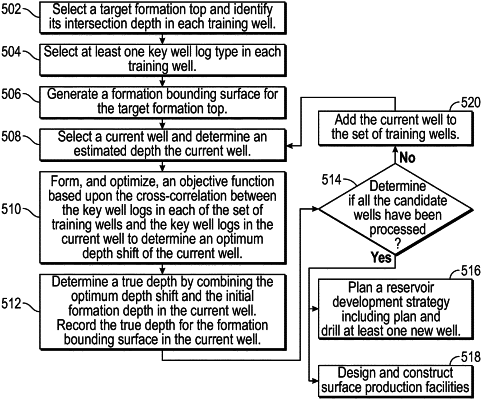| CPC G06F 30/20 (2020.01) [E21B 43/00 (2013.01); G06Q 50/08 (2013.01); E21B 2200/20 (2020.05); G06F 30/13 (2020.01)] | 18 Claims |

|
1. A method comprising:
obtaining, using a computer, at least one key log in each of a set of training wells located within a hydrocarbon reservoir;
identifying a target formation bounding surface in each of the set of training wells;
generating, by the computer, an initial depth surface for the target formation bounding surface from the target formation bounding surface in each of the set of training wells;
determining, by the computer, from the initial depth surface for the target formation bounding surface an initial depth estimate of the target formation bounding surface at a location of a current well;
forming, by the computer, an objective function based on a correlation between each key log in each of the set of training wells and each corresponding key log in the current well to determine an optimum depth shift of the current well;
optimizing, by the computer, the objective function by varying a depth shift between each of the set of training wells and the current well, to determine an optimum depth shift that produces an extremum of the objective function;
combining, by the computer, the initial depth estimate of the target formation bounding surface at the location of the current well with the optimum depth shift to produce a final depth estimate of the target formation bounding surface at the location of the current well;
planning a new well trajectory within the hydrocarbon reservoir based on the final depth estimate, and
drilling, using a drill rig, a new well within the hydrocarbon reservoir guided by the new well trajectory,
wherein the objective function comprises a top correlation score that is a first summation of a plurality of well correlation scores determined for each training well;
wherein each well correlation score of the plurality of well correlation scores is determined as a second summation of a plurality of Pearson correlation coefficients calculated between each of the set of training wells and the current well, and divided by the total number of key well log types that each of the set of training wells and the current well have in common;
wherein the Pearson correlation coefficient is a function of depth shift, and
wherein a key log comprises a resistivity log, a gamma ray log, a density log, or a sonic slowness log.
|